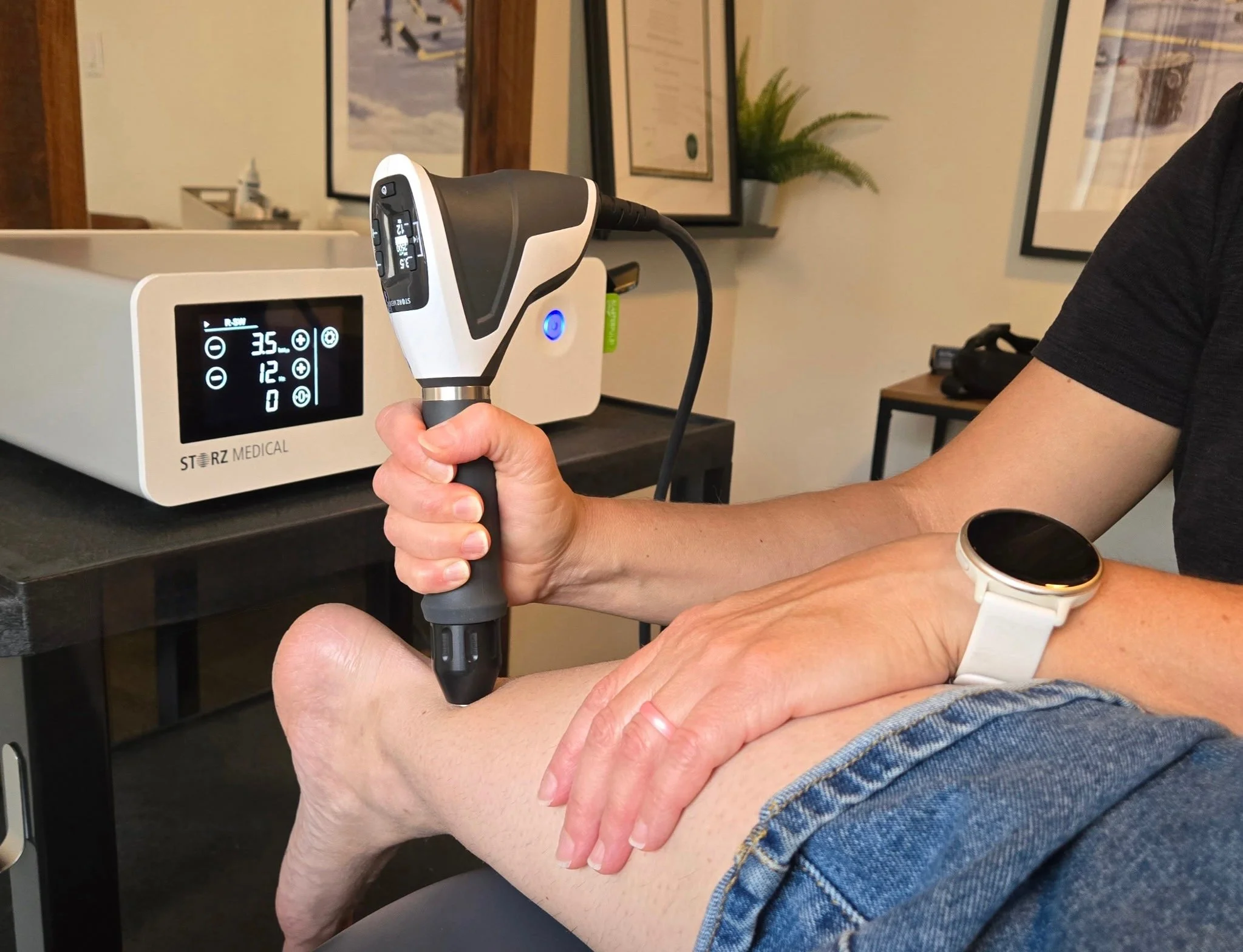What is Shockwave Therapy?
Shockwave therapy, also known as Extracorporeal Shockwave Therapy (ESWT), is a safe, non-invasive treatment used to relieve pain and stimulate healing in injured muscles, tendons, ligaments, and other soft tissues. It is widely used in the treatment of chronic musculoskeletal conditions, particularly those involving tendinopathies and areas of poor healing.
Shockwave therapy has been supported by numerous clinical studies and is included in treatment guidelines for several conditions (e.g., plantar fasciitis and calcific tendinitis), making it a scientifically backed option in modern physiotherapy care.
How Does Shockwave Therapy Work?
Shockwave therapy delivers acoustic pressure waves (not electrical shocks) to targeted tissues using a handheld device. These waves penetrate the skin and interact with underlying tissues to promote biological healing mechanisms. The therapeutic effects include:
✅ Increased blood flow and angiogenesis (formation of new capillaries)
✅ Stimulation of collagen production for tissue repair
✅ Breakdown of calcifications and scar tissue
✅ Reduction in chronic inflammation
✅ Desensitization of nerve endings involved in pain signaling
✅ Activation of cellular repair processes via mechanotransduction
Conditions Commonly Treated with Shockwave Therapy
Shockwave therapy is most effective in chronic, degenerative conditions where healing has stalled. Indications include:
Tendinopathies:
Plantar fasciitis / Plantar fasciopathy
Achilles tendinopathy
Patellar tendinopathy (Jumper’s Knee)
Rotator cuff tendinopathy (especially supraspinatus tendon)
Hamstring tendinopathy
Lateral epicondylitis (Tennis Elbow)
Medial epicondylitis (Golfer’s Elbow)
Gluteal tendinopathy / Greater Trochanteric Pain Syndrome (GTPS)
Hip and knee tendinopathies
Other Soft Tissue Conditions:
Calcific tendinitis (particularly in the shoulder)
Myofascial pain syndrome and trigger points
Chronic muscle strains
Medial tibial stress syndrome (Shin Splints)
Note: Shockwave therapy is not typically recommended as a first-line treatment but is often used when conservative management has failed or progress has plateaued.
What to Expect After Treatment
Immediately After Shockwave Therapy (First 48 Hours):
To maximize effectiveness, avoid the following:
❌ Ice therapy
❌ Non-steroidal anti-inflammatory medications (NSAIDs) such as ibuprofen, naproxen, or aspirin
❌ Steroid medications or injections (unless prescribed by your physician)
These may interfere with the body’s inflammatory and regenerative response stimulated by the treatment.
Activity Guidelines:
✅ Light daily activity is usually fine
❌ Avoid strenuous exercise, running, jumping, or lifting heavy weights for at least 48 hours
✅ Gradually resume normal activities based on your therapist’s recommendations
Recovery & Rehabilitation
Follow your individualized rehabilitation program, which may include strengthening, manual therapy, or neuromuscular retraining.
Adherence to home exercises and follow-up sessions enhances outcomes and reduces recurrence.
Most patients require 3 to 6 sessions, spaced 1 week apart, but treatment plans vary depending on the condition and severity.
Are There Any Side Effects?
Shockwave therapy is generally well-tolerated. Side effects are typically mild and short-term:
Common side effects may include:
Mild to moderate discomfort during or after treatment
Temporary increase in pain (typically subsides within 24–48 hours)
Localized redness, swelling, or warmth
Mild bruising (petechiae or hematomas)
Skin sensitivity or numbness
Throbbing or tingling sensation
Rare side effects:
Nausea
Dizziness
Local skin irritation (especially if over bony prominences)
Most side effects resolve spontaneously and do not require intervention.
Is Shockwave Therapy Right for You?
Shockwave therapy is a valuable tool for managing chronic pain and promoting healing, but it's not suitable for everyone. Contraindications include:
Pregnancy
Blood clotting disorders
Active infection or open wounds in the treatment area
Tumors or cancer near the application site
Use of blood-thinning medication (in some cases)
Your physiotherapist will conduct a thorough assessment to determine if shockwave therapy is appropriate for your condition.
Summary
Shockwave therapy is an evidence-based, non-surgical treatment option that can help accelerate healing and reduce pain in chronic soft tissue injuries. When combined with a tailored rehabilitation program, it can improve function, mobility, and quality of life.
Always consult a qualified physiotherapist or healthcare provider to determine if shockwave therapy is appropriate for your individual needs.
Francine Eastwood
Physiotherapist, Owner
REclaim Physiotherapy
References (Scientific Backing)
Here are some key studies and guidelines supporting shockwave therapy:
Gerdesmeyer L et al. (2008). Radial extracorporeal shock wave therapy is safe and effective in the treatment of chronic recalcitrant plantar fasciitis. American Journal of Sports Medicine.
Speed C. (2014). A systematic review of shockwave therapies in soft tissue conditions:
focusing on the evidence. British Journal of Sports Medicine.
Rompe JD et al. (2009). Efficacy of shock wave therapy for chronic calcific tendinitis of the shoulder. Journal of Bone & Joint Surgery.
European Society for Musculoskeletal Shockwave Therapy (ESWT Guidelines).

